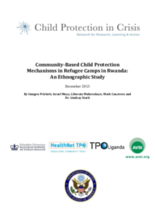EXECUTIVE SUMMARY
Despite the increasing population of refugees stuck in protracted situations and our awareness of the vulnerability of children and adolescents growing in up these contexts, relatively little is known about community based child protection mechanisms (CBCPMs) in refugee communities. CBCPMs, defined broadly, include all groups or networks that respond to and prevent problems of child protection and vulnerable children. These mechanisms may include family supports, peer group supports, and community groups such as primary and secondary schools, non-formal education and vocational training structures, women’s groups, religious groups, and youth groups, as well as traditional community processes, government mechanisms, and mechanisms initiated by international or domestic non-governmental organisations (NGOs). In diverse contexts, CBCPMs represent front-line, day-to-day efforts to protect children from exploitation, abuse, violence, and neglect and to promote children’s well being. This study, together with a parallel study conducted among the urban refugee population in Uganda, is the first study of CBCPMs undertaken in refugee settings.
The purpose of this research is to learn about community-based child protection processes and mechanisms in two refugee camps in Rwanda – Gihembe and Kiziba. In particular, the research seeks to identify what refugees see as the main harms or risks to children, what CBCPMs exist and how they are used, what protective factors enable children’s positive coping and resilience, and whether and how the CBCPMs link with elements of the formal aspects of the child protection system, led by the Rwandan government and Office of the United Nations High Commissioner for Refugees (UNHCR). This study places special emphasis on the linkages between CBCPMs and education-sector groups and structures in order to assess modalities of interaction and collaboration between the two sectors for the strengthening of children’s protective environment.

